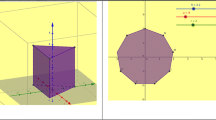Abstract
The aim of the present study was to investigate the nature of global argumentation structures of prospective middle school mathematics teachers in a technology enhanced environment. A qualitative case study was conducted with 8 participants from an Elementary Mathematics Education undergraduate program of one of the public universities in Ankara. Two implementations, 1 of which included 2 geometry tasks on triangles and another which included 2 geometry tasks based on circles, were conducted. Subsequently, global argumentation structures were revealed via data analysis. The findings indicated that the prospective middle school mathematics teachers resort frequently to simple global argumentation structures since their mathematical reasoning was insufficient. On the other hand, technology had a positive impact on argument construction and global argumentation structures of prospective middle school mathematics teachers. However, it was deduced that prospective middle school mathematics teachers need to be challenged on argumentation and about how to facilitate argumentation effectively in their future classroom experiences.















Similar content being viewed by others
References
Anderson, R. C., Chinn, C., Chang, J., Waggoner, M., & Yi, H. (1997). On the logical integrity of children’s arguments. Cognition and Instruction, 15, 135–167.
Antonini, S., & Martignone, F. (2011). Argumentation in exploring mathematical machines: A study on pantographs. In B. Ubuz (Ed.), Proceedings of the 35th Conference of the International Group for the Psychology of Mathematics Education (Vol. 2, pp. 41–48). Ankara, Turkey: Can Tekin Publisher.
Ceylan, T. (2012). Geogebra yazılımı ortamında ilköğretim matematik öğretmen adaylarının geometrik ispat biçimlerinin incelenmesi [Investigating geometry proof structures of prospective elementary mathematics teachers in GeoGebra environment] (Unpublished master’s thesis). Ankara, Turkey: Ankara University.
Conner, A., Singletary, L. M., Smith, R. C., Wagner, P. A., & Francisco, R. T. (2014). Identifying kinds of reasoning in collective argumentation. Mathematical Thinking and Learning, 16, 180–200.
Coşkun, Ş. (2011). A multiple case study investigating the effects of technology on students’ visual and nonvisual thinking preferences: comparing paper-pencil and dynamic software based strategies of algebra word problems (Unpublished doctoral dissertation). Florida: University of Central Florida.
De Villiers, M. (2004). Using dynamic geometry to expand mathematics teachers’ understanding of proof. International Journal of Mathematical Education in Science and Technology, 35(5), 703–724.
Hanna, G., & De Villiers, M. (2008). ICMI study 19: Proof and proving in mathematics education. ZDM––The International Journal on Mathematics Education, 40(2), 329–336.
Inglis, M., Mejia-Ramos, J. P., & Simpson, A. (2007). Modelling mathematical argumentation: The importance of qualification. Educational Studies in Mathematics, 66, 3–21.
Iranzo Domènech, N. (2009). Influence of dynamic geometry software on plane geometry problem solving strategies (Unpublished doctoral dissertation). Barcelona, Spain: Universitat Autònoma de Barcelona.
Jones, K. (2002). Research on the use of dynamic geometry software: Implications for the classroom. Micromath, 18(3), 18–20.
Knipping, C. (2008). A method for revealing structures of argumentations in classroom proving processes. ZDM Mathematics Education, 40(3), 427–441.
Kosko, K. W., Rougee, A., & Herbst, P. (2014). What actions do teachers envision when asked to facilitate mathematical argumentation in the classroom? Mathematics Education Research Journal, 26(3), 459–476.
Krummheuer, G. (1995). The ethnography of argumentation. In P. Cobb & H. Bauersfeld (Eds.), The emergence of mathematical meaning: Interaction in classroom cultures (pp. 229–269). Hillsdale, MI: Lawrence Erlbaum Associates.
Mariotti, A. M. (2006). Proof and proving in mathematics education. In A. Gutierrez & P. Boero (Eds.), Handbook of research on the psychology of mathematics education (pp. 173–204). Rotterdam, The Netherlands: Sense Publishers.
Nardi, E., Biza, I., & Zachariades, T. (2012). “Warrant” revisited: Integrating mathematics teachers’ pedagogical and epistemological considerations into Toulmin’s model for argumentation. Educational Studies in Mathematics, 79(2), 157–173.
National Council of Teachers of Mathematics. (2000). Principles and standards for school mathematics. Reston, VA: NCTM.
Pedemonte, B., & Reid, D. (2011). The role of abduction in proving process. Educational Studies in Mathematics, 76, 281–303.
Posamentier, A. S., & Salkind, C. T. (1988). Challenging problems in geometry. New York, NY: Dover Publications Inc.
Reid, D. A., & Knipping, C. (2010). Proof in mathematics education: Research, learning, and teaching. Rotterdam, The Netherlands: Sense Publishers.
Strom, D., Kemeny, V., Lehrer, R., & Forman, E. (2001). Visualizing the emergent structure of children’s mathematical argument. Cognitive Science, 25(5), 733–773. https://doi.org/10.1207/s15516709cog2505_6.
Toulmin, S. (1958). The uses of argument. New York, NY: Cambridge University Press.
Vincent, J., Chick, H. & McCrae, B. (2005). Argumentation profile charts as tools for analysing students’ argumentations. In H. L. Chick & J. L. Vincent (Eds.), Proceedings of the 29 th PME Conference of the International Group for the Psychology of Mathematics Education (Vol. 4, pp. 281–288). Melbourne, Australia: PME.
Walter, J. G., & Barros, T. (2011). Students build mathematical theory: Semantic warrants in argumentation. Educational Studies in Mathematics, 78(3), 323–342.
Walter, J., & Johnson, C. (2007). Linguistic invention and semantic warrant production: Elementary teachers’ interpretation of graphs. International Journal of Science and Mathematics Education, 5(4), 705–727.
Weiss, R. E. (2003). Designing problems to promote higher-order thinking. New directions for teaching and learning, 95, 25–31.
Yackel, E., & Cobb, P. (1996). Sociomathematical norms, argumentation, and autonomy in mathematics. Journal for Research in Mathematics Education, 27(4), 458–477.
Yackel, E., Ramussen, C., & King, K. (2000). Social and sociomathematical norms in an advanced undergraduate mathematic s course. Journal of Mathematical Behavior, 19, 275–287.
Yemen-Karpuzcu, S., Ulusoy, F., & Işıksal-Bostan, M. (2017). Prospective middle school mathematics teachers’covariational reasoning for interpreting dynamic events during peer interactions. International Journal of Science and Mathematics Education, 15(1), 89–108.
Author information
Authors and Affiliations
Corresponding author
Electronic Supplementary Material
Supplementary file 1
(DOCX 15 kb)
Supplementary file 2
(DOCX 21 kb)
Supplementary file 3
(DOCX 16 kb)
Supplementary file 4
(DOCX 15 kb)
Supplementary file 5
(DOCX 17 kb)
Rights and permissions
About this article
Cite this article
Erkek, Ö., Işıksal Bostan, M. Prospective Middle School Mathematics Teachers’ Global Argumentation Structures. Int J of Sci and Math Educ 17, 613–633 (2019). https://doi.org/10.1007/s10763-018-9884-0
Received:
Accepted:
Published:
Issue Date:
DOI: https://doi.org/10.1007/s10763-018-9884-0




